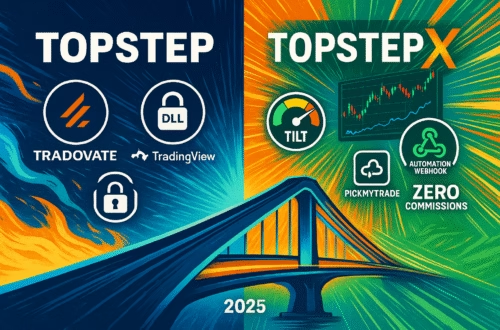The dream of many experienced traders is to start a prop firm—build a firm that funds traders, sets evaluation rules, and shares profits. It’s a high potential business, but launching one requires careful planning, compliance, technology, capital, and execution. In this article, we’ll explain how to start a prop firm in 2025, what pitfalls to watch out for, and how tools like PickMyTrade automation can play a crucial role in your infrastructure.
Why You Might Want to Start a Prop Firm
Before diving into setup, here are some compelling reasons to start a prop firm:
- You can scale trading volume by aggregating successful traders rather than relying solely on your own capital.
- Revenue streams come from evaluation fees, subscription or challenge fees, profit splits, and possibly markups on execution or liquidity.
- The barrier to entry is lower than hedge funds or traditional asset management, especially if you operate challenge-based models.
- Automation and modern tech stacks allow prop firms to operate globally, efficiently, and with lower manpower overhead.
Key Steps to Start a Prop Firm in 2025
Here’s a detailed roadmap (with “start a prop firm” used in headings and subheadings) to get you started:
1. Define Your Business Model & Market Niche
To successfully start a prop firm, first decide which model you’ll use:
- Evaluation / challenge model: Traders pay a fee or pass tests and get funded accounts.
- Direct funding: Provide capital to traders with proven track records without requiring a fee-based challenge upfront.
- Hybrid models: A mix of subscription, challenge fees, and instant funding.
Also define your target markets and assets (forex, futures, equities, crypto), what profit splits and risk rules you’ll set, and how you’ll differentiate from competitors.
2. Conduct Market Research & Write a Business Plan
When you plan to start a prop firm, rigorous research is essential:
- Analyze your competition: what firm rules, fees, profit splits, and trading conditions they offer.
- Define your unique selling proposition (USP): faster payouts, more generous splits, better technology, or trader-friendly rules.
- Build financial projections: estimate challenge fees, funded trader growth, payouts, operating expenses, and profit margins.
3. Legal, Compliance & Structure to Start a Prop Firm
To launch legally, you must address compliance and registration:
- Choose jurisdiction and legal form (LLC, corporation) appropriate to your operations.
- Understand whether licensing is required in your area. Many prop firms do not manage outside client funds, but regulations vary.
- Set up KYC/AML policies, terms & conditions, payout rules, privacy and risk disclaimers.
- Ensure data security, audit trails, and compliance procedures.
4. Secure Capital & Liquidity
Capital and execution are critical to start a prop firm that scales:
- Funding sources: personal capital, investors, or partnerships.
- Liquidity providers or broker partners: ensures fair pricing, fills, and instruments available.
- Reserves to cover losses, payouts, operational costs, and scaling.
5. Build or Acquire Technology Infrastructure
To start a prop firm, robust infrastructure is needed for smooth, scalable operations:
- Trading platforms (e.g. MT4/5, cTrader, proprietary) and connectivity to brokers/liquidity providers.
- Risk management engines to enforce drawdowns, stop-losses, position limits, time limits.
- Trader dashboard, evaluation & challenge portals, CRM for onboarding & support.
- Compliance and audit tools, KYC modules, payout processors.
6. Design Trader Evaluation Programs & Rules
A core component when you start a prop firm is your challenge/evaluation process:
- Define profit targets, drawdown limits (daily and total), minimum trading days, allowed instruments and holding rules.
- Decide consistency rules: e.g. traders must show steady performance, not just one big trade.
- Create payout and scaling policies: how traders move from evaluation to funded accounts, and scaling over time.
7. Establish Risk Management & Compliance Protocols
Risk management is essential when you start a prop firm:
- Build real-time monitoring of exposure, correlation, position sizing, and aggregate risk.
- Implement automated cutoffs for drawdowns, time limits, and trade violations.
- Have escalation and disaster recovery plans for tech failures, trading errors, or extreme market events.
8. Recruit & Onboard Traders
To grow profitably after you start a prop firm, you need good traders:
- Use marketing, SEO, affiliate programs, webinars, content, and communities to attract traders.
- Offer training, clear documentation, transparency in rules, and support to retain high performers.
- Implement analytics to track trader performance, risk behavior, and pass rates.
9. Launch, Monitor & Scale Operations
After you start a prop firm, ongoing work is crucial:
- Pilot launch with a small group of traders to test systems and rules.
- Collect and analyze data: uptime, fills, rule violations, trader success rates, churn.
- Iterate rules, improve automation, marketing, payouts, and platform features.
- Plan scaling: more capital, more asset classes, geographic expansion, regulatory growth.
Click Here To Start a Prop Firm Automation For Free
Incorporating PickMyTrade Automation When You Start a Prop Firm
Using automation is a competitive advantage for modern prop firms. Here’s how PickMyTrade can integrate when you start a prop firm:
- Automated rule enforcement: PickMyTrade can help traders automate their strategies under firm rules, ensuring compliance with drawdown, position sizing, stop-loss, and profit targets.
- Plug-in execution from alerts: When your traders use signals (e.g. from TradingView), PickMyTrade can execute trades automatically via broker APIs, reducing execution delays and manual errors.
- Monitoring & dashboards: You can build oversight tools for your prop firm using automation platforms to track trader behavior, rule violations, latency, and consistency.
- Scaling infrastructure: With automation tools, your firm can support more traders with less manual supervision, enabling growth more efficiently.
When you start a prop firm today, integrating automation platforms like PickMyTrade gives you a technological edge in onboarding, monitoring, and scaling traders.
Challenges & Common Pitfalls When You Start a Prop Firm
Even with a strong plan, many new prop firms encounter issues. Here are key pitfalls and how to mitigate them:
- Underestimating capital needs and reserves: Not just for trading losses but for tech, support, compliance, and marketing.
- Poor risk management or edge-case rule definitions (e.g., what happens if profit target and drawdown are hit in same trade).
- Lack of transparency or poor payout experience – leads to reputational damage and difficulty recruiting quality traders.
- Inadequate technology or scaling readiness – slow execution or downtime kills trader trust.
- Regulatory issues from operating in jurisdictions without proper licensing or KYC/AML process.
Summary: Launching a Prop Firm in 2025
To start a prop firm in 2025, you’ll need a clear business model, compliance and capital structure, scalable technology, well-defined evaluation rules, smart risk management, trader recruitment, and plans for scaling. Incorporating automation tools like PickMyTrade can greatly improve execution, compliance, and monitoring and give your firm a competitive advantage. With proper planning, resources, and continuous iteration, launching a successful prop firm is achievable but demands discipline and persistence.
Frequently Asked Questions (FAQs) About Starting a Prop Firm
Q1: Do I need a financial license to start a prop firm?
It depends on your jurisdiction and whether you accept outside client funds. Many prop firms operate under challenge-based models without needing full brokerage licenses, but legal advice is essential.
Q2: How much capital do I need to start a prop firm?
Estimates vary widely, but many sources suggest you need at least $50,000-$200,000 for technology, risk reserves, and operations. Larger firms often require much more.
Q3: What types of revenue does a prop firm generate?
Typical revenue includes evaluation/challenge fees, subscription or reset fees, profit splits, commission markups, spread or swap markups, and premium services.
Q4: How do I recruit and retain good traders?
Transparency in rules and payouts, supportive education/training, competitive profit splits, and fast execution help attract and retain talent. Clear marketing, community building, and testimonials also help.
Q5: Can automation platforms guarantee compliance with prop firm rules?
Automation, like with PickMyTrade, helps enforce rules, reduce manual error, and improve consistency, but it cannot guarantee full compliance—edge cases, rule updates, and human oversight are still needed.
Q6: What are the biggest risks when starting a prop firm?
Risks include underfunding, regulatory non-compliance, technical failures, hidden rule ambiguity, poor payout reliability, and inability to scale effectively.
Q7: How long does it take to launch a prop firm?
Typical timelines vary: research & business planning may take 2-4 weeks, compliance setup and licensing 6-12 weeks, tech integration 4-8 weeks, marketing setup another few weeks. Overall, it can take 3-6 months to launch.
Also Checkout: ProjectX vs Tradovate: Complete Comparison for Futures Traders





